Question
1. N10.1. In a certain economy the production function is Y=A(100N0.5N2), where Y is output, A is productivity, and N is total hours worked. The
1. N10.1. In a certain economy the production function is Y=A(100N0.5N2), where Y is output, A is productivity, and N is total hours worked. The marginal product of labor associated with this production function is MPN=A(100N). Initially, A=1.0, but a beneficial productivity shock raises A to 1.1. a. The supply of labor is NS=45+0.1w, where w is the real wage. Find the equilibrium levels of output, hours worked, and the real wage before and after the productivity shock. Recall that the MPN curve is the same as the labor demand curve, with the real wage replacing the MPN. b. Repeat part (a) if the labor supply is NS=10+0.8w. c. Some studies show that the real wage is only slightly procyclical. Assume for the sake of argument that this finding is correct. Would a calibrated RBC model fit the facts better if the labor supply is relatively insensitive to the real wage, or if it is relatively sensitive? Justify your answer diagrammatically and relate it to your answers to parts (a) and (b). 2. A10.3. Consider a business cycle theory that combines the classical IS- LM model with the assumption that temporary changes in government purchases are the main source of cyclical fluctuations. How well would this theory explain the observed cyclical behavior of each of the following variables? Give reasons for your answers. a. Employment b. The real wage c. Average labor productivity d. Investment e. The price level.3. A11.1. According to the Keynesian IS-LM model, what is the effect of each of the following on output, the real interest rate, employment, and the price level? Distinguish between the short run and the long run. a. Increased tax incentives for investment (the tax breaks for investment are offset by lump-sum tax increases that keep total current tax collections unchanged). b. Increased tax incentives for saving (as in part (a), lump-sum tax increases offset the effect on total current tax collections). c. A wave of investor pessimism about the future profitability of capital investments. d. An increase in consumer confidence, as consumers expect that their incomes will be higher in the future. 4. A11.4. Classical economists argue that using fiscal policy to fight a recession doesn't make workers better off. Suppose, however, that the Keynesian model is correct. Relative to a policy of doing nothing, does an increase in government purchases that brings the economy to full employment make workers better off? In answering the question, discuss the effects of the fiscal expansion on the real wage, employment, consumption, and current and future taxes. How does your answer depend on (a) the direct benefits of the government spending program and (b) the speed with which prices adjust in the absence of fiscal stimulus? 5. A11.5. Some labor economists argue that it is useful to think of the labor market as being divided into two sectors: a primary sector, where "good" (high paying, longterm) jobs are located, and a secondary sector, which has "bad" (lowpaying, shortterm) jobs. Suppose that the primary sector has a high marginal product of labor and that (because effort is costly for firms to monitor) firms pay an efficiency wage. The secondary sector has a low marginal product of labor and no efficiency wage; instead, the real wage in the secondary sector adjusts so that the quantities of labor demanded and supplied are equal in that sector. Workers are alike, and all would prefer to work in the primary sector. However, workers who can't find jobs in the primary sector work in the secondary sector. What are the effects of each of the following on the real wage, employment, and output in both sectors? a. Expansionary monetary policy increases the demand for primary sector output. b. Immigration increases the labor force.c. The effort curve changes so that a higher real wage is needed to elicit the greatest effort per dollar in the primary sector. Effort exerted at the higher real wage is the same as before the change in the effort curve. d. There is a temporary productivity improvement in the primary sector. e. There is a temporary productivity improvement in the secondary sector.
Step by Step Solution
There are 3 Steps involved in it
Step: 1

Get Instant Access to Expert-Tailored Solutions
See step-by-step solutions with expert insights and AI powered tools for academic success
Step: 2

Step: 3

Ace Your Homework with AI
Get the answers you need in no time with our AI-driven, step-by-step assistance
Get Started


